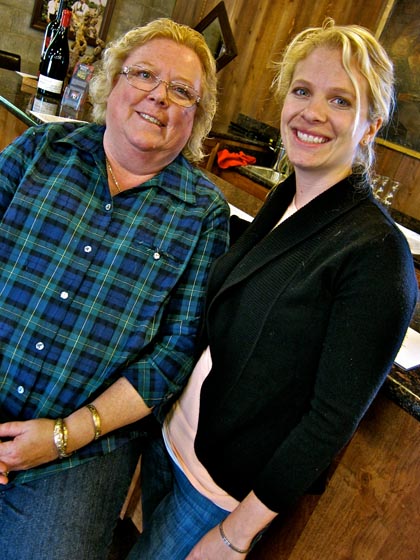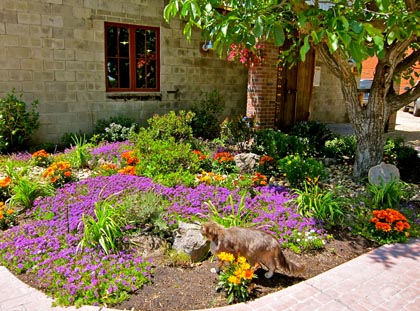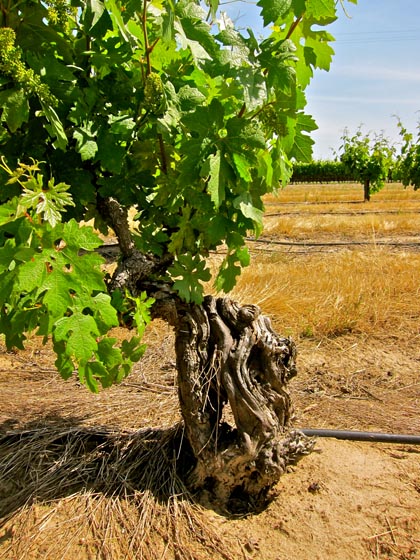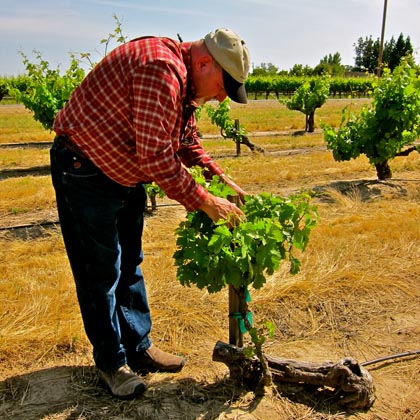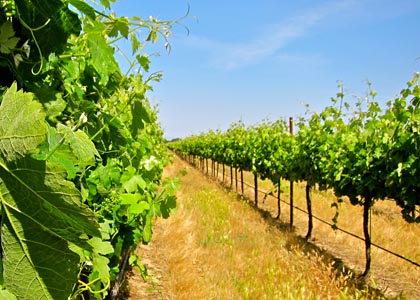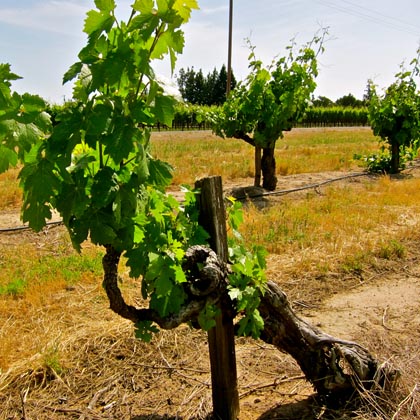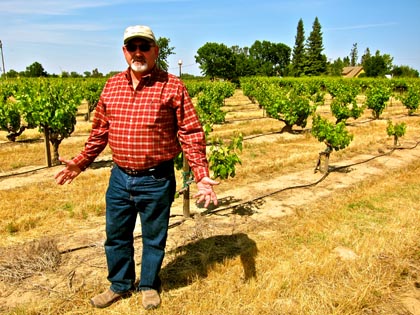Letters from Lodi
An insightful and objective look at viticulture and winemaking from the Lodi
Appellation and the growers and vintners behind these crafts. Told from the
perspective of multi-award winning wine journalist, Randy Caparoso.
The unsinkable Klinker Brick
Klinker Brick's Steve Felten
A quintessential Lodi wine country story…
When things go bad, the old saw goes, you take lemons and turn them into lemonade. Steve Felten, the colorful yet pensive winemaker/proprietor of Klinker Brick Winery, tells us that when he was first forced to turn grapes into wine, he wasn’t exactly thrilled by the prospect. “It started in 1995,” he says, “when we lost our contracts with Gallo, which drove us into making wine to sell on the bulk market… we had to do something with our grapes. After a while, it made sense to start bottling these wines under our own label, and we haven’t looked back since.”
Lori & Farrah Felten
“But up until then,” says Mr. Felten, “winemaking never crossed my mind. I grew up with grape growing, from my mother’s father’s side (Felten’s father was a Lodi restaurateur, who owned and ran Felten’s Topaz and El Charro on two sides of N. Cherokee Lane for many years); and on my wife’s side (the former Lori Mehlhaff), farming in Lodi goes back to the late 1800s… melons, Tokay, Carignane, Alicante Bouschet, and of course, Zinfandel.
“When I married Lori and started up Felten Mehlhaff Farm (founded in 1990), the plan was to be grape growers the rest of our lives. But winemaking really does take a bite out of you, and now I can’t imagine doing anything else. So when Gallo came back later to see if we could sign a new contract, I told them it’s too late, no more grapes for you – the Felten family has officially gone over to winemaking!”
Today, Steve and Lori Felten are a quintessential Lodi born and raised couple: driven to make the best of circumstances, and handsomely succeeding. As soft spoken as he is, Mr. Felten is also one of Lodi’s most eloquent spokespersons, sitting down with us last week to tell his story – his way:
“Lori and I are the 5th generation involved in winegrowing here in Lodi, and our daughter Farrah (25 years old) represents the 6th. Up until recently, Farrah was concentrating on marketing, assisting Lynne (Lynne Whyte Barnard, Klinker Brick’s President) in sales. But since opening our tasting room during last February’s Wine & Chocolate Weekend, we’ve discovered a whole new market in itself, and so we’ve taken Farrah off the road so she can take over as our tasting room manager.
The newly opened Klinker Brick tasting room
“Since coming aboard in 2003, Lynne really has been the one to make things go. Bringing over 25 years of prior experience in the distribution business, she’s expanded Klinker Brick into 40 states; and by the end of 2012, the plan is to be in all 50 states.”
Classic Klinker Brick old vine
It’s not just the winemaking bug that the Feltens have caught, it’s the entire endeavor, including sales and marketing. “This business consumes you – you have to love it or leave it,” says Felten. “We all spend a lot of time in the markets. We hit everybody at least once a year, some twice, and bigger markets like Texas, four or five times.
“Things have been moving right along. Sales grew 29% last year, and we’ve already exceeded that this year. We’re up to just over 30,000 cases a year – the largest percentage of that by far (about 26,000 cases) with our bread and butter, the Klinker Brick Old Vine Zinfandel. In much more limited quantities, we have our Farrah Syrah, our Old Ghost Zinfandel, and the latest addition to the Klinker Brick line, a 2010 Rosé.
“We started the winery with the 2000 vintage of Old Vine Zinfandel. We added the 2001 Farrah the next year, and the 2003 Old Ghost a couple of years later. Old Ghost, of course, represents the best of what we make every year. It is usually a single vineyard selection, although our current vintage, the 2008, is a blend of two vineyards.
“Lynne was also the original driving force behind Old Ghost. One year when she was tasting through the barrels with (consulting winemaker) Barry Gnekow and me, she pointed out one lot and said, ‘this is too good to be blended into the rest of the Old Vine Zinfandel.’ The name came about from an earlier time, when Barry and I were walking through an old, abandoned vineyard, with an early morning fog was creeping through the vines, and I thought, ‘looks like a ghost came through here.’ Lynne came up with the concept of a white on white label – a raised old vine ‘ghost’ embossed on a white background – and I think the packaging, which is phenomenal, has had as much to do with the success as any other thing.
“But Old Ghost really is our best Zinfandel. We keep our options open each vintage – it could come from any one of our 15 major vineyards, although usually it’s one of about six that tend to stand out each year. Interestingly enough, in 2008 for the first time our oldest vineyard – a 117 year old block we’ve been farming the past seven, eight years, which rarely produces over 1½ tons per acre – made it into the Old Ghost for the first time, and it’s made a beautiful blend with a historic 2½ acre, 94 year old, dry farmed vineyard off Cherry Rd., north of Victor, which has been meticulously reshaped into classic small vines over the past few years. If we ever come out with single vineyard bottlings of Zinfandel – which is well within the realm of possibility, now that we’ve opened our tasting room – it’s our Cherry Rd. vineyard that would most likely be the first.
Tending to 94 year old rehabilitated, dry farmed zin vines off Victor Rd.
“We now farm about 600 acres total, about 250 of which we own – most of that consisting of very old vine zin, plus our 16 acres of Syrah called Farrah Vineyard, which has had that name since the time Farrah was 9, 10 years old, when she first began to go out to tie up and train the vines up on their stakes, along with a couple of her friends. Before starting the winery, we were managing up to 2,000 acres, on both the east and west sides of Lodi, but we’ve cut back because so much of our energy is now put into the winemaking, and especially sales, which requires unending monitoring.
“I love the farming part of the business, but over the past five years Les Dunning, who’s been with us for 13 years, has basically taken over the management of the vineyards. Joseph Smith is our winemaker, and Barry still plays a major role as our consulting winemaker.
“As far as vineyards go, we’re now concentrated on the eastern side (i.e. east of Hwy. 99) of Lodi, as far up as Clements. I guess this is because it’s what I know best, and what I prefer. The east side of Lodi has a drier climate; and although the sandy loam is pretty much the same as on the west side of the Mokelumne River AVA, the water table tends to be deeper and a soils a little more well drained, and so we get a little more concentration and structure in our wines. Vines that are less vigorous, producing fewer clusters and smaller berries, will give you that character, and this an important part of the Klinker Brick style.”
The Farrah Vineyard: Syrah with a vengeance
The family’s history told, Mr. Felten tasted us through the current releases of Klinker Bricks:
2010 Klinker Brick, Lodi Rosé ($15) – This bone dry pink wine, according to Felten, “is my alternative to beer on a hot summer day.” Indeed, it is light and crisp, with floral scents suggesting sweet tea and strawberries. Vinified from Syrah, Grenache, Carignane and Zinfandel grapes, and highly recommended with summery, mesclun mixed salads in, say, berry infused vinaigrettes, or else Niçoise style, with slivered black olives, cherry tomatoes, wedges of boiled egg and virtually any choice of shredded fish (especially tuna, salmon or anchovy).
Lodi's ancient vines often look like they're hobbling around on crutches
2008 Klinker Brick, Lodi Old Vine Zinfandel ($18) – Felten tells us that as many as 13, 14 vineyards go into this blend, with vines averaging a staggering 85 years of age. The other unique aspect of Klinker Brick’s nationally known pièce de resistance is the blending grape used: Cabernet Franc, rather than the traditional Petite Sirah. “Cabernet Franc gives our Zinfandel a more structured, elegant feel, and also a softer fruitiness than what we would get with Petite Sirah,” says Felten. Hence: a raspberryish, fruit forward fragrance with fresh, leafy undertones, followed up by a lush, easy texture, and a chubby fruitiness well contained within a fullish yet unencumbered body. The perfect vinous solution for smoky, slow Weber or oil drum cooked, falling-off-the-bone pork ribs rubbed with brown sugar, cayenne, paprika, and lots of other tasty stuff.
2008 Klinker Brick, Old Ghost Lodi Old Vine Zinfandel ($37) – As densely textured and replete in sweet, brambly and pepper/cardamom spiced varietal qualities as the Old Ghost can be, it is never really a hefty, tannin or oak driven, or oversized (i.e. unwieldy alcohol) style of Zinfandel. The ’08 is true to the identity in its thick yet compact feel, doling out a pure, spicy zin fruitiness in juicy dribs and drabs. A solid yet unobtrusive core of tannin does make this more of a steak wine… ah, the hissing of summer grills.
2009 Klinker Brick, Farrah Lodi Syrah ($20) – With brutal honesty, Mr. Felten acknowledges that sticking with Syrah through the recent slings and arrows of marketing misfortune (says Felten, “Syrah has never really caught on with consumers and turned into the next-big-thing we were told it would be when we first planted it 17 years ago”) has made their recent success with the grape all the more satisfying. “We don’t make a lot of the Syrah, but it’s developed enough of a following that it’s now one of our allocated items,” he tells us. Boy, are we glad they’ve kept the faith, because the Klinker Brick Syrah is a killer: starting with its vivid purplish color and luscious nose exuding sweet strawberry, raspberry and cherry bomb fruits; flavors of which dig deep into the palate via bright, zesty, medium-full, well rounded sensations. “Farrah is definitely an American Syrah,” says Felten, “heavier than European styles (i.e. reds from France’s Northern Rhône Valley), but lighter than Australian styles (i.e. Shiraz). Try this sturdy yet lavishly fruited varietal red with grill roasted peppers, portobellos, or Chinese broccoli, along with chili spiced meats (like Jamaican jerk or Texan style beef), and guaranteed, Klinker Brick will make a Syrah believer out of you, too!

